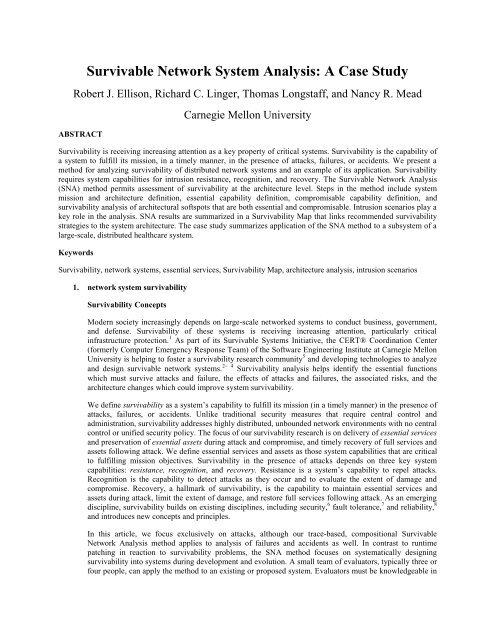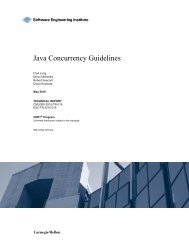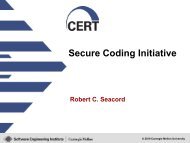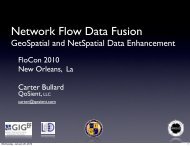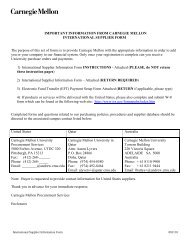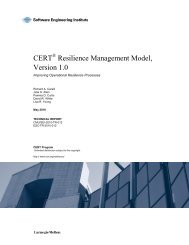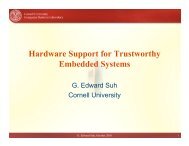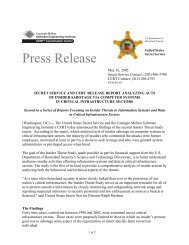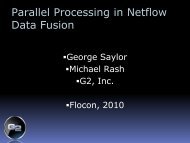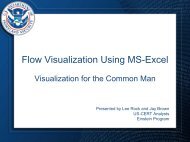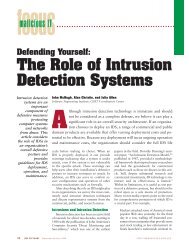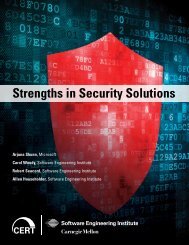Survivable Network System Analysis: A Case Study - Cert
Survivable Network System Analysis: A Case Study - Cert
Survivable Network System Analysis: A Case Study - Cert
You also want an ePaper? Increase the reach of your titles
YUMPU automatically turns print PDFs into web optimized ePapers that Google loves.
<strong>Survivable</strong> <strong>Network</strong> <strong>System</strong> <strong>Analysis</strong>: A <strong>Case</strong> <strong>Study</strong><br />
Robert J. Ellison, Richard C. Linger, Thomas Longstaff, and Nancy R. Mead<br />
ABSTRACT<br />
Carnegie Mellon University<br />
Survivability is receiving increasing attention as a key property of critical systems. Survivability is the capability of<br />
a system to fulfill its mission, in a timely manner, in the presence of attacks, failures, or accidents. We present a<br />
method for analyzing survivability of distributed network systems and an example of its application. Survivability<br />
requires system capabilities for intrusion resistance, recognition, and recovery. The <strong>Survivable</strong> <strong>Network</strong> <strong>Analysis</strong><br />
(SNA) method permits assessment of survivability at the architecture level. Steps in the method include system<br />
mission and architecture definition, essential capability definition, compromisable capability definition, and<br />
survivability analysis of architectural softspots that are both essential and compromisable. Intrusion scenarios play a<br />
key role in the analysis. SNA results are summarized in a Survivability Map that links recommended survivability<br />
strategies to the system architecture. The case study summarizes application of the SNA method to a subsystem of a<br />
large-scale, distributed healthcare system.<br />
Keywords<br />
Survivability, network systems, essential services, Survivability Map, architecture analysis, intrusion scenarios<br />
1. network system survivability<br />
Survivability Concepts<br />
Modern society increasingly depends on large-scale networked systems to conduct business, government,<br />
and defense. Survivability of these systems is receiving increasing attention, particularly critical<br />
infrastructure protection. 1 As part of its <strong>Survivable</strong> <strong>System</strong>s Initiative, the CERT® Coordination Center<br />
(formerly Computer Emergency Response Team) of the Software Engineering Institute at Carnegie Mellon<br />
University is helping to foster a survivability research community 5 and developing technologies to analyze<br />
and design survivable network systems. 2− 4 Survivability analysis helps identify the essential functions<br />
which must survive attacks and failure, the effects of attacks and failures, the associated risks, and the<br />
architecture changes which could improve system survivability.<br />
We define survivability as a system’s capability to fulfill its mission (in a timely manner) in the presence of<br />
attacks, failures, or accidents. Unlike traditional security measures that require central control and<br />
administration, survivability addresses highly distributed, unbounded network environments with no central<br />
control or unified security policy. The focus of our survivability research is on delivery of essential services<br />
and preservation of essential assets during attack and compromise, and timely recovery of full services and<br />
assets following attack. We define essential services and assets as those system capabilities that are critical<br />
to fulfilling mission objectives. Survivability in the presence of attacks depends on three key system<br />
capabilities: resistance, recognition, and recovery. Resistance is a system’s capability to repel attacks.<br />
Recognition is the capability to detect attacks as they occur and to evaluate the extent of damage and<br />
compromise. Recovery, a hallmark of survivability, is the capability to maintain essential services and<br />
assets during attack, limit the extent of damage, and restore full services following attack. As an emerging<br />
discipline, survivability builds on existing disciplines, including security, 6 fault tolerance, 7 and reliability, 8<br />
and introduces new concepts and principles.<br />
In this article, we focus exclusively on attacks, although our trace-based, compositional <strong>Survivable</strong><br />
<strong>Network</strong> <strong>Analysis</strong> method applies to analysis of failures and accidents as well. In contrast to runtime<br />
patching in reaction to survivability problems, the SNA method focuses on systematically designing<br />
survivability into systems during development and evolution. A small team of evaluators, typically three or<br />
four people, can apply the method to an existing or proposed system. Evaluators must be knowledgeable in
a number of disciplines, including architecture analysis, intrusion techniques, and survivability strategies.<br />
2. The <strong>Survivable</strong> <strong>Network</strong> <strong>Analysis</strong> method<br />
Figure 1 depicts the SNA method’s four steps. To use the method, a team reviews mission objectives and<br />
requirements for a current or candidate system and elicits the structure and properties of its architecture in<br />
Step 1. In Step 2, the team identifies essential services and assets, based on mission objectives and the<br />
consequences of failure. Usage scenarios characterize essential service and asset uses. These scenarios are<br />
mapped onto the architecture as execution traces to identify the composition of corresponding essential<br />
components, which must be available to deliver essential services and maintain essential assets. In Step 3,<br />
the team selects intrusion scenarios based on the system environment and an assessment of risks and<br />
intruder capabilities. CERT’s extensive knowledge base of intrusion strategies also influences<br />
selections.These scenarios are likewise mapped onto the architecture as execution traces to identify<br />
corresponding compositions of compromisable components, or components that intrusion could penetrate<br />
and damage.<br />
Figure 1. The <strong>Survivable</strong> <strong>Network</strong> <strong>Analysis</strong> Method<br />
The SNA method takes COTS components’ strengths and weaknesses into account, as well as any known<br />
security and reliability flaws. In Step 4, the team identifies the architecture’s softspot components as<br />
components that are both essential and compromisable, based on the results of Steps 2 and 3. The team then<br />
analyzes softspot components and their supporting architectures for the key survivability properties of<br />
resistance, recognition, and recovery. The analysis of the "three Rs" is summarized in a survivability map.<br />
The map is a matrix that enumerates, for every intrusion scenario and its corresponding softspot effects, the<br />
current and recommended architecture strategies for resistance, recognition, and recovery. The survivability<br />
map provides feedback on the original architecture and system requirements and often results in an iterative<br />
process of cost-benefit analysis and survivability improvement. Although we developed the SNA method<br />
for use with large-scale distributed-network systems, it is equally applicable to other architectures,<br />
including host-based and real-time systems. SNA’s scenario-based approach is a generalization of<br />
operation sequence 9 and usage scenario methods. 10,11<br />
3. Sentinel: the case study subsystem<br />
Mental health treatment management is often a manual process with handwritten forms and informal
communication. As a result, substantial time and effort are consumed to coordinate various treatment<br />
providers, including physicians, social service agencies, and healthcare facilities. CarnegieWorks Inc. is<br />
developing a large-scale, comprehensive management system to automate, systematize, and integrate<br />
multiple aspects of regional mental healthcare. The CWI system, named Vigilant, will ultimately contain<br />
some 22 subsystems that will operate on a distributed client/server network and maintain a large, complex<br />
database of patient and provider records.<br />
A vital part of the Vigilant system is its development and management of treatment plans. A provider<br />
develops a treatment plan for a patient. The provider identifies each patient’s problems together with a set<br />
of goals and actions, including medication and therapy, to achieve those goals. An interdisciplinary and<br />
interorganizational action team composed of providers carries out each treatment plan.<br />
Treatment plan development and management and action team definition and coordination are key<br />
functions of Sentinel (a subsystem of Vigilant), which resides on a node in the network architecture and<br />
communicates with other nodes through network protocols. Sentinel interacts with other subsystems, with<br />
individual providers, and affiliations of providers that deliver healthcare services. Sentinel maintains the<br />
action teams and treatment plans as part of the Vigilant patient database, and it applies regulatory and<br />
business rules for treatment plan development and validation. Because of the critical nature of mental<br />
health treatment, the need to conform to regulatory requirements, and the severe consequences of system<br />
failure, CWI personnel identified survivability of key Sentinel capabilities as an essential requirement.<br />
4. Applying the SNA method to sentinel<br />
We applied the SNA method to the Sentinel subsystem architecture through a structured series of meetings between<br />
our team and Sentinel project personnel (the customer and development teams). We break down specific results<br />
from this case study below in terms of the four SNA steps and their corresponding artifacts.<br />
Step 1: <strong>System</strong> definition<br />
The following normal usage scenarios, or NUS, elicited from Sentinel requirements documentation characterize the<br />
subsystem’s principal mission objectives. Each scenario includes a statement of the primary Sentinel responsibility<br />
with respect to the scenario:<br />
♦ NUS1—Enter a new treatment plan. A provider assigned to a patient admitted into an affiliation performs<br />
an initial assessment and defines a treatment plan that specifies problems, goals, and actions. Sentinel must<br />
apply business rules to the treatment plan definition and validation.<br />
♦ NUS2—Update a treatment plan. A provider reviews a treatment plan, possibly adding or changing<br />
problems, goals, or actions, and possibly updating the status of these items. Sentinel must apply business rules<br />
to the treatment plan update and validation.<br />
♦ NUS3—View a treatment plan. A provider treating a patient views a treatment plan to learn the status of<br />
problems, goals, and actions. Sentinel must ensure that the displayed plan is current and valid.<br />
♦ NUS4—Create or modify an action team. A provider defines or changes treatment team membership in a<br />
patient’s affiliation. Sentinel must ensure that the treatment team definition is current and correct.<br />
♦ NUS5—Report the current treatment plans in an affiliation. An administrator views the current state of his<br />
or her affiliation’s treatment of a patient or set of patients. Sentinel must ensure that the treatment plan<br />
summaries are current and correct.<br />
♦ NUS6—Change patient medication. A provider changes the medication protocol in a treatment plan for a<br />
patient, possibly in response to unforeseen complications or side effects. Sentinel must ensure that the treatment<br />
plan is current and valid.<br />
Figure 2 shows the original Sentinel architecture obtained from design documentation. The evaluation team used<br />
execution traces of the normal usage scenarios identified in Step 1 to illuminate and understand architectural
properties. The traces revealed component sequencing within the architecture, as well as the referencing and<br />
updating of database artifacts.<br />
Figure 2. Original Sentinel Architecture<br />
As shown in Figure 2, the user interface resides outside of Sentinel to allow a single interface to serve multiple<br />
subsystems and components. The application program interface, or API, provides synchronous remote procedure<br />
call and asynchronous messaging facilities for the user interface and other system components to use. The list<br />
manager maintains lists, including patients, affiliations, providers, and action teams, and the relationships among<br />
them. The reporting engine provides read-only viewing and reporting of Sentinel artifacts, including current<br />
treatment plans and their histories. The treatment plan builder creates treatment plans for patients, including<br />
problems, goals, and actions; the treatment plan validator checks the completeness and consistency of treatment plan<br />
development and modification. The action team builder provides capability to define and modify action team<br />
membership. Business logic contains enterprise-defined business rules, including validation checks for treatment<br />
plan development and logging triggers that manage change control of sensitive data. In the common database,<br />
Sentinel shares access to data with other subsystems and components.<br />
Step 2: Essential capability definition<br />
We based the essential service and asset analysis on the normal usage scenarios identified in Step 1. The analysis<br />
pointed to a single essential service, namely NUS3: the capability to view treatment plans. This service, more than<br />
any other, was deemed most essential to delivery of mental health treatment because providers depend on real-time,<br />
on-demand access to treatment plans in clinical situations, particularly for emergency situations involving<br />
medication or therapy problems.<br />
The other services could be postponed for hours or even days in the event of system intrusion and compromise.<br />
The analysis also identified a single essential asset: the treatment plans. Preservation of treatment plan integrity and
confidentiality was deemed essential to meeting Sentinel mission objectives. The other Sentinel artifacts, such as<br />
action teams, affiliations, and providers, could all be reconstructed or updated hours or days after intrusion with no<br />
irreversible consequences.<br />
The execution trace of the NUS3 scenario revealed that the reporting engine and the database components, as well as<br />
their supporting components and artifacts, are essential to maintaining the capability to perform the scenario. As<br />
essential assets, the integrity and confidentiality of treatment plans depends on database components for security and<br />
validation.<br />
Step 3: Compromisable capability definition<br />
Based on the system environment and assessment of intruder objectives and capabilities, we selected the following<br />
set of five intrusion usage scenarios, or IUS, as representative of the types of possible attacks on Sentinel. We<br />
selected the intrusions based on customer priorities, as well as on our judgment and experience, for their ability to<br />
illuminate the risks and vulnerabilities that the essential services could experience. We judged the scenarios<br />
sufficient to cover the exposures; additional scenarios considered did not add significantly to the findings. The<br />
description for each scenario consists of an IUS number, the type of attack (shown in parentheses), and a brief<br />
explanation:<br />
♦ IUS1 (data integrity and spoofing attack)—An intruder swaps the patient identifications between two<br />
validated treatment plans.<br />
♦ IUS2 (data integrity and insider attack)—An insider uses other legitimate database clients to modify or<br />
view treatment plans controlled by Sentinel.<br />
♦ IUS3 (spoofing attack)—An unauthorized user employs Sentinel to modify or view treatment plans by<br />
spoofing a legitimate user.<br />
♦ IUS4 (data integrity and recovery attack)—An intruder corrupts major portions of the database, leading to a<br />
loss of trust in validated treatment plans.<br />
♦ IUS5 (insider and availability attack)—An intruder destroys or limits access to Sentinel's software so that it<br />
cannot retrieve treatment plans.<br />
The execution traces of the five IUSs revealed various component vulnerabilities. IUS1 compromised the treatment<br />
plan component; no validity checks on the treatment plans were made after their initial entry. IUS2 also<br />
compromised the treatment plan component; the treatment plan changes might have been made by an improper<br />
agent. In IUS3, the treatment plan component is likewise compromised; the system architecture included terminals<br />
in open areas that could be accessed by unauthorized users. IUS4 compromised the treatment component as well; the<br />
system architecture emphasized user capabilities, and system backup and recovery had not received equivalent<br />
attention. IUS5 affected all software components, including the reporting engine; although there were implicit user<br />
requirements for availability, they had not been considered in the original system architecture.<br />
Step 4: Survivability analysis<br />
As we noted earlier, softspot components are both essential and compromisable. Our analysis showed that the<br />
reporting engine component and the database treatment plan component can both be compromised in a variety of<br />
ways.<br />
<strong>Analysis</strong> of the three Rs resulted in the survivability map depicted by Table 1. Development of the table began with<br />
the matching of each intrusion scenario trace, created in Step 3 above, to softspot components. We first checked<br />
each trace to determine if any current resistance components (described in the resistance column of the survivability<br />
map for each scenario) in the architecture could increase the difficulty an intruder would confront in reaching the<br />
softspots referenced in the trace. Because no detailed implementation information was available to identify specific<br />
vulnerabilities in these resistance components, we assumed that implementation vulnerablities would be identified<br />
and corrected later.
Table 1. The Sentinel subsystem survivability map.<br />
Intrusion scenario Resistance strategy Recognition strategy Recovery strategy<br />
IUS1:<br />
Current:<br />
Current:<br />
Current:<br />
An intruder swaps the<br />
patient Ids of two<br />
validated TPs.<br />
Two passwords required for<br />
TP access.<br />
Logging of changes made to DB.<br />
Provider might recognize an<br />
incorrect TP.<br />
Built-in recovery in commercial DB.<br />
Backup and recovery scheme defined.<br />
Recommended:<br />
Recommended:<br />
Recommended:<br />
Implement<br />
strong<br />
authentication supported in a<br />
security API layer. 1<br />
Add cryptographic checksum when<br />
TP is validated. 3 Verify<br />
cryptographic checksum when TP<br />
is retrieved. 4<br />
Implement a recovery mode in the user<br />
interface to support searching for and<br />
recovering incorrect TPs. 1<br />
IUS2:<br />
Current:<br />
Current:<br />
Current:<br />
An intruder uses other<br />
legitimate DB clients<br />
to modify or view TPs<br />
controlled by Sentinel.<br />
Security model for DB field<br />
access.<br />
Recommended:<br />
None.<br />
Recommended:<br />
Scrap data and start over, or use a<br />
backup and verify entries.<br />
Recommended:<br />
Verify adequacy of existing<br />
security model with respect to<br />
the integration of future<br />
system components.<br />
Perform a validation on access of a<br />
TP for verification. 2 Add<br />
cryptographic checksum when TP<br />
is validated. 3 Verify this checksum<br />
when TP is retrieved. 4<br />
Scan DB for invalid crypto-checksums<br />
and/or invalid TPs and recover to last<br />
known correct TP. 4<br />
IUS3:<br />
Current:<br />
Current:<br />
Current:<br />
An unauthorized user<br />
employs Sentinel to<br />
modify or view TPs<br />
by spoofing a<br />
legitimate user.<br />
None. No timeout is<br />
specified—anyone can use a<br />
logged-in terminal. Intruder<br />
only has access to logged-in<br />
user’s TPs.<br />
None, except for the unusual<br />
number of denied accesses to TPs<br />
as an intruder attempts to locate<br />
particular TPs.<br />
Can get list of modified TPs through the<br />
spoofed user's transaction history.<br />
Manually recover each modified record.<br />
Recommended:<br />
Recommended:<br />
Recommended:<br />
Add a short log-out timeout for<br />
any terminals in uncontrolled<br />
areas. 1<br />
Add logging, access control, and<br />
illegal access thresholds to the<br />
security API. 1<br />
Develop a recovery procedure and<br />
support it in the application user<br />
interface. 1<br />
IUS4:<br />
Current:<br />
Current:<br />
Current:<br />
An intruder corrupts<br />
major portions of the<br />
DB leading to a loss<br />
of trust in validated<br />
TPs.<br />
Security model in the DB<br />
protects data against<br />
corruption.<br />
Recommended:<br />
None, except when provider<br />
happens to recognize a corrupted<br />
TP.<br />
Recommended:<br />
Locate an uncorrupted backup or<br />
reconstruct TPs from scratch.<br />
Recommended:<br />
Implement live replicated DB<br />
systems that cross-check for<br />
validity. 5<br />
Add and check cryptographic<br />
checksums on records in the DB. 3,4<br />
Reduce the backup cycle to quickly<br />
rebuild once a corrupted DB is detected. 5
IUS5:<br />
Current:<br />
Current:<br />
Current:<br />
An intruder destroys<br />
or limits access to<br />
Sentinel’s software so<br />
that it cannot retrieve<br />
TPs.<br />
No procedures defined.<br />
Recommended:<br />
Focus on quick recovery.<br />
<strong>System</strong> does not work.<br />
Recommended:<br />
None. Easy to detect.<br />
Reload the system from backups.<br />
Recommended:<br />
Maintain software archives and define<br />
procedures for fast recovery. Create a<br />
small subsystem that can retrieve TPs<br />
while Sentinel software is down. 6<br />
ID stands for identification, TP for treatment plan, and DB for database. References are to architecture<br />
components.<br />
For the recognition column, we followed a similar process. To assess the effectiveness of current recognition<br />
components, we made a number of assumptions (noted in the survivability map). For example, in IUS3 in Table 1,<br />
we assume that a provider will become suspicious when there are a large number of denied accesses to treatment<br />
plans. If this assumption is not valid, then there are no current recognition strategies associated with this scenario.<br />
For the recovery column, we made assumptions regarding standard practice in distributed database management<br />
facilities—standard backup and recovery of the database and version control of the Sentinel software. Table entries<br />
for current recovery strategies included these assumptions. If they are not satisfied in the final system, the recovery<br />
strategies will be less effective than those described in the survivability map.<br />
Once we identified the current resistance, recognition, and recovery strategies, we analyzed gaps and weaknesses to<br />
locate common points in the architecture where a particular survivability improvement could address multiple<br />
scenarios or strategies. These high-leverage recommendations are listed in a consistent form and identified as a<br />
common recommendation. We also addressed other gaps for which there is no existing strategy in the resistance,<br />
recognition, or recovery columns.<br />
For the resistance column, we made recommendations even where an existing resistance mechanism existed, as this<br />
mechanism can be expected to degrade over time. Ultimately, the system architect must determine the costs and<br />
benefits of implementing these recommendations. The survivability map can help an architect determine the impact<br />
of accepting risks associated with weaknesses in the resistance, recognition, or recovery columns, as these have a<br />
correlation to the intrusion scenarios that can affect the system’s essential services or assets. Table 1 identifies a<br />
number of gaps and assumptions in the current strategies. Of particular interest to an architect are those<br />
recommendations that deal with multiple intrusion scenarios. For example, adding a cryptographic checksum to the<br />
validation of a treatment plan can minimize the risks in several scenarios. A cryptographic checksum could be a<br />
hash function or message digest applied to the fields of the treatment plan to provide an integrity check on the<br />
contents.<br />
Figure 3 illustrates the modified architecture resulting from the survivability map analysis. Many of the<br />
recommendations call for alterations to the same architectural component. To further illustrate the overlaps, the<br />
recommendations are annotated with a reference number (1-6) associated with the modified architecture. This makes<br />
it easy to determine which recommendations would alleviate risks in multiple intrusion scenarios. This view of the<br />
recommendations can help the architect allocate limited resources to high-impact modifications of the architecture.<br />
In modifying the architecture to address the recommendations in the survivability map, several natural locations<br />
emerged where changes could be implemented with minimal impact to the overall system. This beneficial<br />
localization was primarily due to the functional decomposition used in the original architecture. It is also likely that<br />
the scenario evaluations led to recommendations that were natural to the architecture, because their impact on<br />
individual modules was evident.
Figure 3. The Sentinel architecture with survivability modifications (additions and changes shown with<br />
dashed lines and shading).<br />
In addition to using these findings for architectural analysis, Sentinel personnel could also use the findings to make<br />
modifications to system requirements. Step 1 revealed that few specific survivability requirements were specified<br />
other than requiring treatment plan validation, utilization of security features built into the standard login process<br />
and the database, and a development strategy that permits easy modification so that security features could be added.<br />
Changes are thus needed at the highest level to two areas of the requirements; under survivability conditions, there is<br />
a requirement for providers to view treatment plans within a reasonable time, and a requirement to protect the<br />
integrity of the treatment plans in the database.<br />
The SNA method is under continuing development and additional case studies on large-scale network systems are<br />
underway. The method’s success depends on the effectiveness of its recommendations; that is, how well the system<br />
meets the survivability requirements selected by the customer in terms of essential services and assets, given the<br />
extent to which the SNA recommendations are implemented. Of equal importance is whether the customer can<br />
readily incorporate the SNA recommendations into the existing software development process, and thus be able to<br />
adopt the suggested changes. Because the survivability recommendations for Sentinel concentrated on refining an<br />
existing architecture, rather than on requiring a redesign, they satisfied this criterion.<br />
Although most of the recommendations focused on revisions to the application architecture, several called for<br />
changes in design and implementation, or in operations and procedures. The study also raised questions about the<br />
system’s extensibility: Could the proposed architecture support, from a survivability perspective, the functionality<br />
desired in later versions? The SNA process raises questions about all of the design choices that are embodied in a<br />
system architecture. Future studies will explore how to leverage architectural choices to better support survivability,<br />
in the same way that this study leveraged the survivability capabilities of the relational database infrastructure.<br />
The SNA method represents the first word, not the last, on the complex problem of assessing system survivability.<br />
Much work remains to be done, such as developing theory and practice for rigorous system behavior and<br />
architecture definitions, creation of canonical intrusion scenarios that embody current knowledge of attack<br />
strategies, integrating risk analysis and management techniques into the method, and quantifying survivability<br />
metrics and measures of success.<br />
Acknowledgments
We thank Howard Lipson and David Fisher of the SEI CERT/CC for their contributions to the definition of the SNA<br />
method. We thank Cindi Carbine of CarnegieWorks Inc. and Carnegie Mellon University’s Master of Software<br />
Engineering student developers Melissa Cheok, Ryan Soulier, Grama Srinivasan, Shinji Yamato, and Isabel Yebra<br />
for their support and cooperation in conducting this study. CERT and the CERT Coordination Center are registered<br />
in the US Patent and Trademark Office. The Software Engineering Institute is a federally funded research and<br />
development center sponsored by the US Department of Defense.<br />
References<br />
1. Critical Foundations: Protecting America’s Infrastructures: The Report of the President’s Commission on Critical<br />
Infrastructure Protection, Government Printing Office, Washington, D.C., 1997.<br />
2. R.J. Ellison et al., <strong>Survivable</strong> <strong>Network</strong> <strong>System</strong>s: An Emerging Discipline, Tech. Report CMU/SEI-97-TR-013,<br />
Pittsburgh, Penn., Software Engineering Institute, Carnegie Mellon University, Nov. 1997 (revised May 1999).<br />
3. R.C. Linger, N.R. Mead, and H.F. Lipson, "Requirements Definition for <strong>Survivable</strong> <strong>Network</strong> <strong>System</strong>s," Proc. Int’l<br />
Conf. on Requirements Engineering, IEEE Computer Soc. Press, Los Alamitos, Calif., 1998, pp 14-23.<br />
4. R.J. Ellison et al., A <strong>Case</strong> <strong>Study</strong> in <strong>Survivable</strong> <strong>Network</strong> <strong>System</strong> <strong>Analysis</strong>, Tech. Report CMU/SEI-98-TR-014,<br />
Pittsburgh, Penn., Software Engineering Institute, Carnegie Mellon University, Sept. 1998.<br />
5. Proc. Information Survivability Workshop, IEEE Computer Soc. Press, Los Alamitos, Calif., 1998;<br />
www.cert.org/research/isw98.html .<br />
6. R.C. Summers, Secure Computing: Threats and Safeguards, McGraw-Hill, New York, 1997.<br />
7. V. Mendiratta, "Assessing the Reliability Impacts of Software Fault-Tolerance Mechanisms," Proc. Int’l Symp. on<br />
Software Reliability Engineering, IEEE Computer Soc. Press, Los Alamitos, Calif., 1992, pp 99-103.<br />
8. J. Musa, A. Iannino, and K. Okumoto, Software Reliability: Measurement, Prediction, and Application, McGraw-Hill,<br />
New York, 1987.<br />
9. R.A. Kemmerer and P.A. Porras, "Covert Flow Trees: A Visual Approach to Analyzing Covert Storage Channels,"<br />
IEEE Trans. on Software Eng., Vol.17, No.11, Nov. 1991, pp. 1166− 1185.<br />
10. J.M. Carrol, "Five Reasons for Scenario-Based Design," Proc. Hawaii Int’l Conf. on <strong>System</strong>s Sciences, IEEE Computer<br />
Soc. Press, Los Alamitos, Calif., 1999, p 123..<br />
11. S.J. Prowell et al., Cleanroom Software Engineering: Technology and Process, Addison/Wesley Longman, Reading, Mass., 1999.<br />
Robert J. Ellison is a senior member of the technical staff in the <strong>Network</strong>ed <strong>System</strong>s Survivability Program at the<br />
SEI. His research interests include system survivability, software development environments, and CASE tools. He<br />
has a PhD in mathematics from Purdue University. He is a member of the ACM and the IEEE Computer Society.<br />
Richard C. Linger is a visiting scientist in the <strong>Network</strong>ed <strong>System</strong>s Survivability Program at the SEI and an adjunct<br />
faculty member at the Heinz School of Public Policy and Management, Carnegie Mellon University. His research<br />
interests include survivable systems, semantics of network architectures, large-scale system development, cleanroom<br />
software engineering, software project management, and process improvement. He holds a BSEE from Duke<br />
University and is a member of the ACM and IEEE.<br />
Thomas Longstaff is currently managing research and development in network security for the <strong>Network</strong>ed <strong>System</strong>s<br />
Survivability Program at the SEI. His research interests include information survivability and critical national<br />
infrastructure protection. He has a PhD in computer science from the University of California, Davis.<br />
Nancy R. Mead is a senior member of the technical staff in the <strong>Network</strong>ed <strong>System</strong>s Survivability Program at the<br />
SEI, and a faculty member in the Master of Software Engineering, Carnegie Mellon University. She is currently<br />
involved in the study of survivable systems architectures, and the development of professional infrastructure for<br />
software engineers. She has also served as Director of Education for the SEI. Her research interests are in software<br />
requirements engineering, software architectures, software metrics, and real-time systems. She has a PhD in<br />
mathematics from Polytechnic Institute of New York. She is a senior member of the IEEE and IEEE Computer
Society, and a member of ACM.


